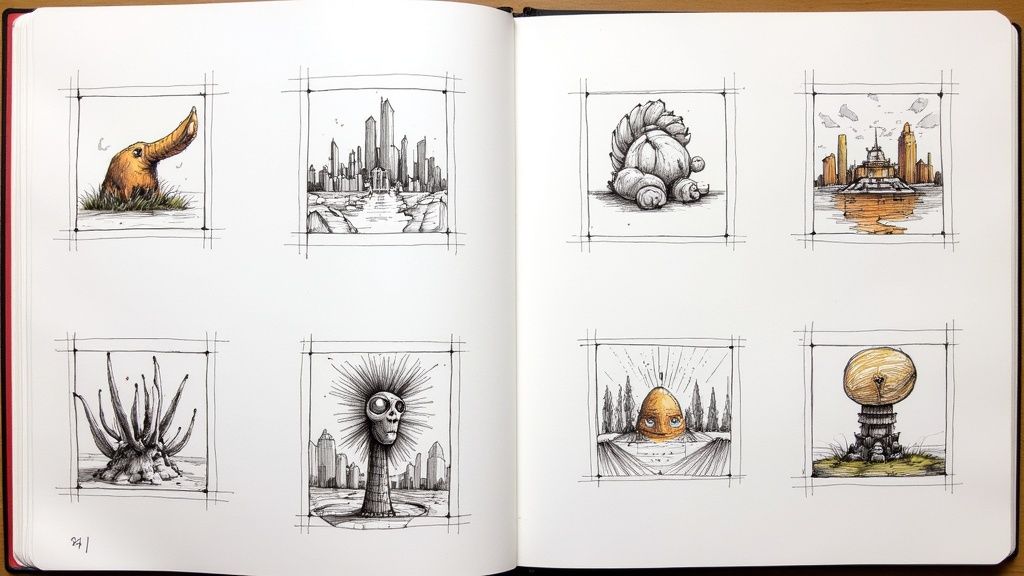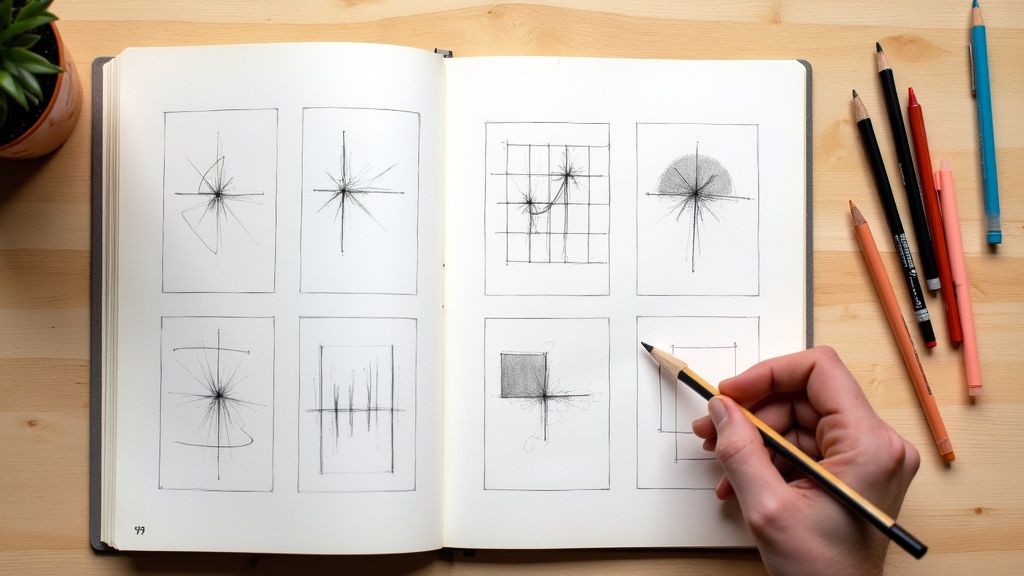Welcome, artists and doodlers! Are you looking to fill your sketchbook with charming creatures or find a fresh style for your next project? This guide is a curated collection exploring seven distinct and popular styles for creating cute animal drawings. We move beyond generic prompts to provide a structured approach to illustration, ensuring you have the specific techniques needed to bring your ideas to life.
From the super-simplified charm of Japanese Kawaii to the expressive world of digital art, each section offers actionable tips and practical examples to help you master a new aesthetic. We will delve into specific methods for achieving each look, from minimalist line art animals to detailed watercolor portraits. This roundup is designed to be your go-to resource for inspiration and technical guidance.
By exploring these diverse approaches, you will build a versatile toolkit to conquer creative blocks and develop your unique artistic voice. Whether you are a beginner seeking a starting point or an experienced illustrator aiming to experiment, you will find fresh perspectives to elevate your work. Let’s explore the techniques that transform a simple sketch into a truly adorable animal illustration.
1. Kawaii-style Animals
The Kawaii style is a Japanese cultural aesthetic centered entirely around the concept of cuteness. When applied to cute animal drawings, this approach transforms subjects into irresistibly charming characters by using specific, simplified design principles. Think of iconic figures like Hello Kitty or the creatures from Pokémon; they all leverage the Kawaii aesthetic to evoke feelings of warmth and affection.
This style, popularized by companies like Sanrio and artists such as Yuko Shimizu, is perfect for creating designs that are universally appealing and emotionally resonant. The core idea is to capture a baby-like essence, which triggers our natural nurturing instincts. This is achieved through exaggerated proportions and a minimalist approach to detail, focusing the viewer's attention on the most endearing features.
Creating Your Kawaii Character
To master this style, focus on specific proportional rules and a minimalist mindset. The goal is not realism but an amplified sense of adorable innocence.
- Proportions are Key: The most defining feature is the eyes. They should be large, simple circles or ovals, taking up at least 30% of the head’s total surface area. Place them low on the face to mimic the proportions of an infant.
- Embrace Simplicity: Use soft, rounded shapes for the entire body. Avoid sharp angles or complex anatomical details. The mouth should be very small and simple, often just a tiny dot or a soft curve.
- Add Expressive Details: Small, rosy blush marks placed high on the cheeks are a classic Kawaii trope that instantly adds a touch of shyness and charm. Ensure features are largely symmetrical to maintain a sense of simple, pleasing harmony.
- Limit Your Color Palette: Stick to a soft, pastel-heavy color scheme. Using just three or four harmonious colors keeps the design clean and gentle on the eyes, reinforcing the overall cute and innocent feel.
The following infographic highlights the core design principles for creating authentic Kawaii-style animals.
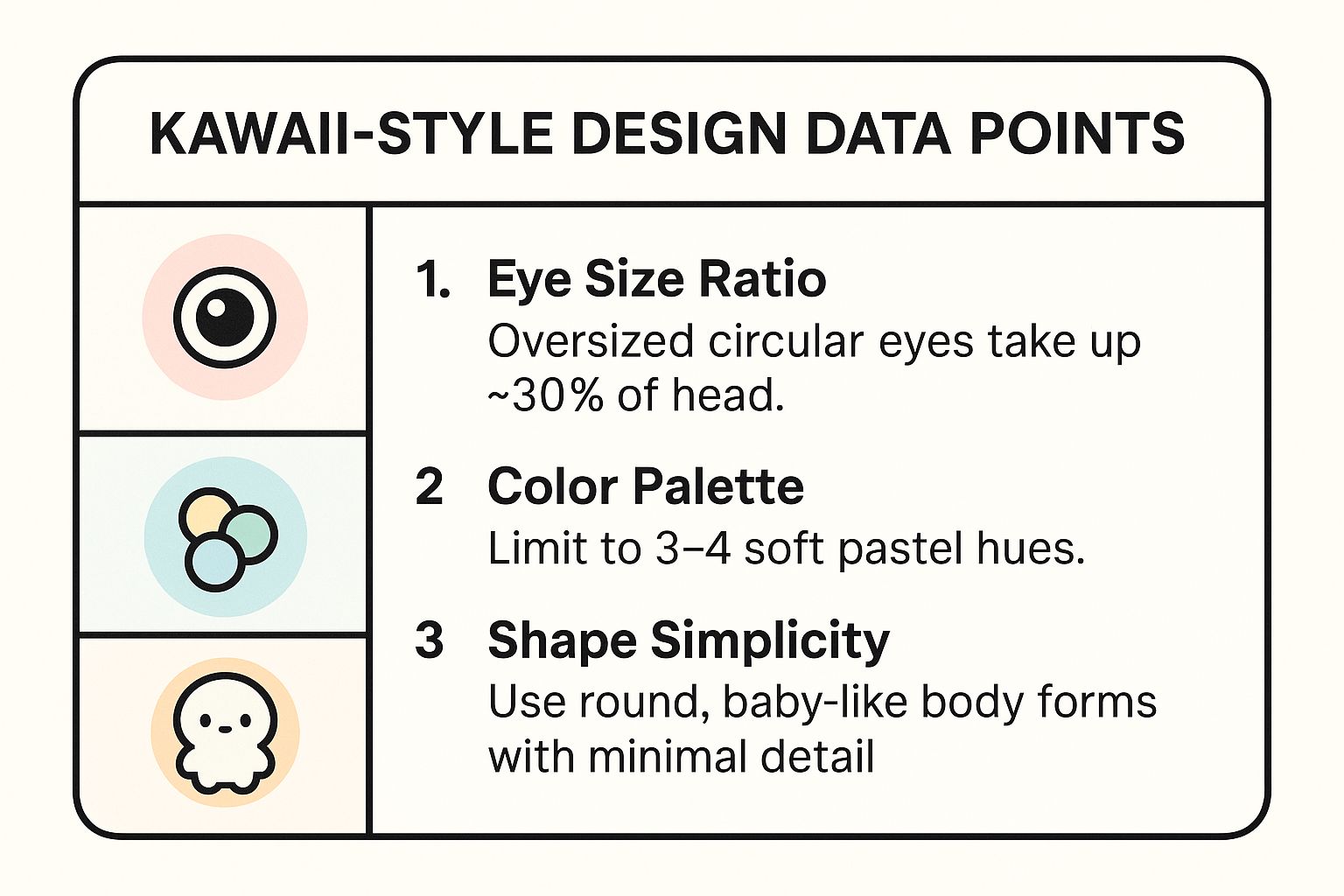
These visual rules work together to create a powerful, immediate impression of cuteness that defines the Kawaii aesthetic.
2. Chibi Animal Art
Chibi is a Japanese slang term that translates to "short" or "small," and in the world of art, it describes a specific style of super-deformed character drawing. When applied to cute animal drawings, the Chibi approach exaggerates proportions to an extreme, resulting in characters with massive heads, diminutive bodies, and simplified, expressive features that amplify their playful and adorable nature.
This style is heavily influenced by anime and manga, where it's often used for comedic effect or to create highly marketable merchandise like Nendoroid figures and mobile game avatars. The core principle of Chibi art is to distill a character down to its most recognizable and endearing traits, creating a compact, powerful burst of cuteness. It is an excellent style for artists looking to create expressive stickers, emojis, or charming character concepts. For more inspiration, you can find a variety of cute drawing ideas on drawinglist.com.
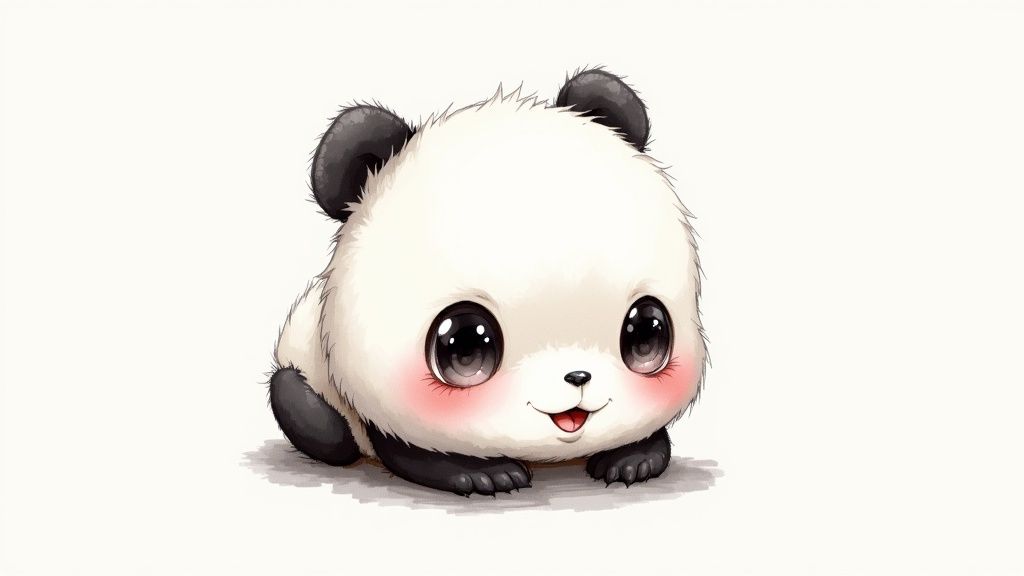
Creating Your Chibi Character
To draw a successful Chibi animal, you must embrace exaggeration and simplification. The aim is not just to make the animal small, but to re-imagine its proportions entirely for maximum emotional impact.
- Proportions are Key: The head is the star of the show. Start with a large circle for the head and ensure the body is typically no taller or wider than the head itself. This head-to-body ratio, often close to 1:1, is the defining characteristic of the Chibi style.
- Embrace Simplicity: Use bold, simple shapes for the entire figure. Limbs are often short, stubby nubs without detailed joints like elbows or knees. This enhances the child-like, toy-like quality of the drawing.
- Add Expressive Details: Since the body is so small, the face must do all the emotional heavy lifting. Exaggerate the eyes and mouth to convey a wide range of feelings, from joy to surprise. Also, amplify the animal’s key identifying features, like a squirrel’s bushy tail or a rabbit’s long ears, making them prominent.
- Limit Your Color Palette: While not as strict as Kawaii, using a clean and focused color scheme helps the bold shapes stand out. Bright, saturated colors often work well to match the energetic and playful vibe of Chibi designs.
3. Watercolor Animal Portraits
Watercolor cute animal drawings combine the soft, flowing nature of watercolor painting with adorable animal subjects. This style creates dreamy, gentle artworks that emphasize the tender qualities of animals through translucent colors and organic textures. The unpredictable yet beautiful way watercolors bleed and blend on paper makes each piece unique, lending a whimsical and heartfelt quality to the art.
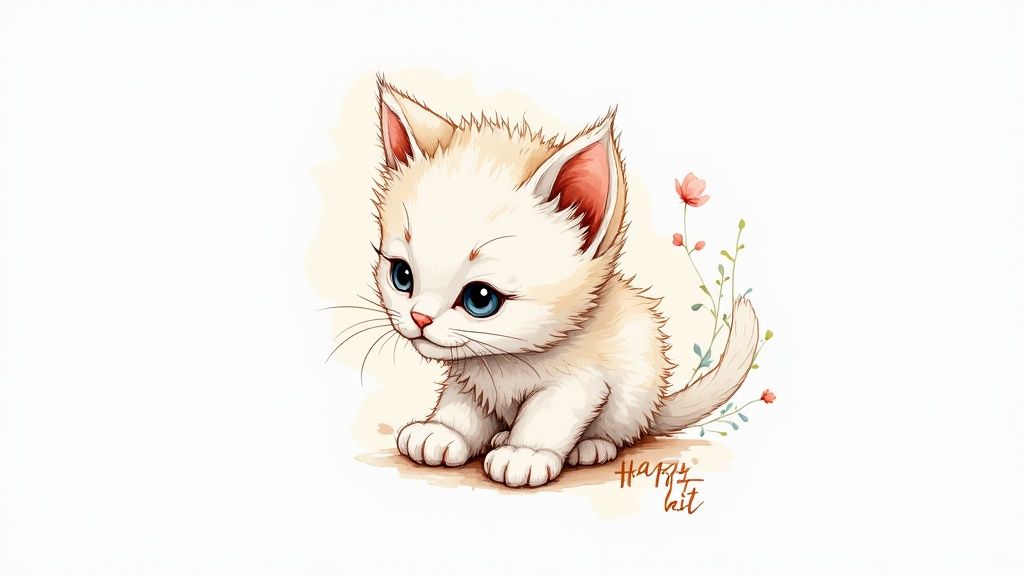
Popularized by classic illustrators like Beatrix Potter and revitalized by contemporary artists on platforms like Etsy and Instagram, this style is perfect for nursery wall art, custom pet portraits, and greeting cards. The core idea is to let the medium do much of the expressive work, using its natural transparency and fluidity to suggest soft fur, wet noses, and gentle eyes. This approach gives the artwork a timeless, delicate charm that captures the innocent spirit of the animal.
Creating Your Watercolor Portrait
To master this style, you need to understand the behavior of your materials and learn to control the flow of water and pigment. The goal is a balance between deliberate strokes and happy accidents, resulting in a lively and endearing portrait.
- Materials Matter: Start with high-quality, cold-press watercolor paper (140 lb or 300 gsm minimum) to prevent buckling. This heavy paper can handle multiple washes of water without falling apart, which is essential for layering colors.
- Build Color Gradually: Begin with very light, diluted washes of color to block in the basic shapes of your animal. Let each layer dry completely before adding darker, more detailed layers on top. This technique, called glazing, creates depth and richness.
- Preserve the Whites: Unlike other paints, you can't easily add white back into a watercolor painting. Plan ahead and leave the white of the paper untouched for the brightest highlights, like the sparkle in an eye or the shine on a nose.
- Experiment with Textures: Use the wet-on-wet technique (applying wet paint to wet paper) for soft, blurry backgrounds or fluffy fur. For more detailed textures, sprinkle salt onto a wet wash; as it dries, the salt crystals will push the pigment away, creating a unique, speckled effect.
4. Vector-style Flat Design Animals
Vector-style flat design simplifies animals into their most essential geometric forms, using solid colors and clean lines to create modern, polished illustrations. This digital-first approach emphasizes clarity and scalability, resulting in cute animal drawings that are both stylish and highly versatile. Think of the simplified graphics in app icons, website banners, or educational materials; these designs communicate ideas quickly while maintaining a friendly, approachable feel.
This style was heavily popularized by digital design leaders like Google's Material Design team and Apple's iOS interface guidelines, as well as the broader design community on platforms like Dribbble. The core principle is to remove unnecessary details like gradients, shadows, and textures, focusing instead on shape, color, and silhouette to convey the animal's character. This minimalist aesthetic creates a look that feels clean, contemporary, and universally understandable.
Creating Your Vector-style Character
To achieve this clean and modern look, you must think like a graphic designer, focusing on fundamental shapes and a cohesive visual language. The goal is to distill the animal's essence into a simple, iconic representation.
- Start with Basic Shapes: Build your animal from foundational geometric forms like circles, ovals, triangles, and rectangles. A cat's head might be a circle, its ears triangles, and its body a rounded rectangle.
- Master the Pen Tool: For creating precise curves and custom shapes, the pen tool in vector software (like Adobe Illustrator or Figma) is essential. It allows for smooth, controlled lines that define the flat design aesthetic.
- Maintain Consistent Stroke Weights: If you use outlines, keep the line thickness uniform throughout your illustration. This consistency creates a sense of harmony and professionalism in your design.
- Choose a Deliberate Color Palette: A limited, complementary color scheme is key. Use bold, solid colors that work well together to make your drawing pop. Flat design relies on color relationships to create depth and interest.
- Focus on Distinctive Features: Exaggerate the one or two features that make an animal instantly recognizable. For an elephant, it's the trunk and large ears; for a toucan, it's the oversized, colorful beak. Simplicity makes these key details stand out even more.
5. Realistic Pencil Animal Sketches with Cute Appeal
This style masterfully combines technical drawing skills with a thoughtful selection of subjects to highlight the natural, inherent cuteness of animals. Unlike stylized approaches, this method relies on realism, using graphite pencils to render lifelike textures, proportions, and expressions. The "cute" factor comes from the composition and subject matter, such as focusing on baby animals, capturing playful poses, or emphasizing soft, endearing facial features.
This approach is highly valued in fine art contexts like wildlife galleries, pet portrait commissions, and classical art illustrations. Artists like Robert Bateman and Carl Brenders, though known for majestic wildlife art, often capture tender moments that resonate with a sense of gentle appeal. The goal is to create emotionally impactful, cute animal drawings that are also respected for their technical proficiency and anatomical accuracy.
Creating Your Realistic Sketch
To create a realistic drawing that still feels cute, you must balance technical skill with emotional storytelling. The key is using precise techniques to enhance, not overshadow, the animal's natural charm.
- Choose a Strong Reference: Start with a high-quality, high-resolution photograph. Look for images that feature soft lighting, clear eye detail, and an engaging pose or expression. A baby animal exploring its surroundings or a pet in a moment of calm are excellent subjects.
- Use a Full Range of Pencils: A common mistake is using only one or two pencil grades. To achieve depth and realism, use a variety of hardnesses, such as a 2H for light initial outlines, HB for mid-tones, and softer pencils like 4B or 6B for deep shadows and rich darks.
- Build Tones Gradually: Avoid pressing hard from the start. Instead, build up your values in light, successive layers. This technique, called layering, allows for subtle gradations and prevents the paper from becoming waxy or difficult to work with.
- Focus on the Eyes: In realism, the eyes are the focal point that brings the subject to life. Pay meticulous attention to capturing the reflections (catchlights), the moisture on the waterline, and the delicate texture of the surrounding fur to create a soulful and expressive gaze.
- Soften with Blending Tools: Use blending stumps or tortillons to smooth out graphite for seamless transitions, which is especially important for rendering soft fur or smooth skin. This helps create a tangible sense of softness that enhances the cute appeal.
For those interested in exploring this medium further, there are many detailed drawing ideas with pencil available to practice and refine these techniques.
6. Digital Art Stylized Animals
Digital stylized animal art utilizes modern digital painting software and hardware to create cute animal drawings with enhanced colors, creative lighting, and unique artistic interpretations. This approach blends traditional art principles with the powerful tools of digital media, allowing for effects like vibrant glow, complex textures, and perfect gradients that are difficult to achieve with conventional methods. Think of the stunning character designs in modern animated films or the imaginative creatures found in video game concept art.
This style, popularized by concept artists in the gaming and film industries and amplified by communities on Instagram and DeviantArt, is perfect for creating polished, professional-looking artwork. Digital tools offer unparalleled flexibility, enabling artists to experiment fearlessly with color, composition, and form. The ability to undo mistakes, work in layers, and apply post-processing effects makes it an accessible yet incredibly deep medium for bringing imaginative cute animal drawings to life.
Creating Your Digital Art Masterpiece
To excel in this style, you must combine artistic fundamentals with technical know-how. The goal is to leverage digital tools to enhance your creative vision, not replace your artistic skill.
- Invest in Your Tools: A quality drawing tablet with pressure sensitivity is essential. This allows for natural-feeling brush strokes where the thickness and opacity of your lines change with how hard you press.
- Master Your Layers: Learn to use layers effectively. Separating your sketch, line art, base colors, shadows, and highlights onto different layers gives you complete control and makes it easy to make adjustments without starting over.
- Study Color and Light: Digital art thrives on dramatic lighting and harmonious color palettes. Study traditional color theory and observe how light interacts with different surfaces to create depth and mood in your drawings.
- Explore Custom Brushes: Most digital art programs allow you to download or create custom brushes. Using varied brushes can add unique textures for fur, scales, or feathers, giving your stylized animals a more tactile and interesting appearance.
- Work in High Resolution: Always start your canvas at a high resolution, such as 300 DPI (dots per inch). This ensures your final artwork is sharp and clear, making it suitable for high-quality prints or viewing on large displays.
7. Minimalist Line Art Animals
Minimalist line art focuses on capturing the essence of an animal using only the most essential lines and shapes. This elegant style strips away unnecessary detail, relying instead on clean, confident strokes and the clever use of negative space to create cute animal drawings that are both simple and profoundly expressive. The beauty of this approach lies in its ability to be instantly recognizable and charming with very little visual information.
This style, famously explored by artists like Pablo Picasso with his single-line animal sketches and embraced by modern logo designers and tattoo artists, is perfect for creating sophisticated and timeless art. The core idea is to distill a subject down to its most defining characteristics. This forces the artist to make deliberate choices about which lines are critical to convey the animal's form and personality, resulting in a powerful and focused piece.
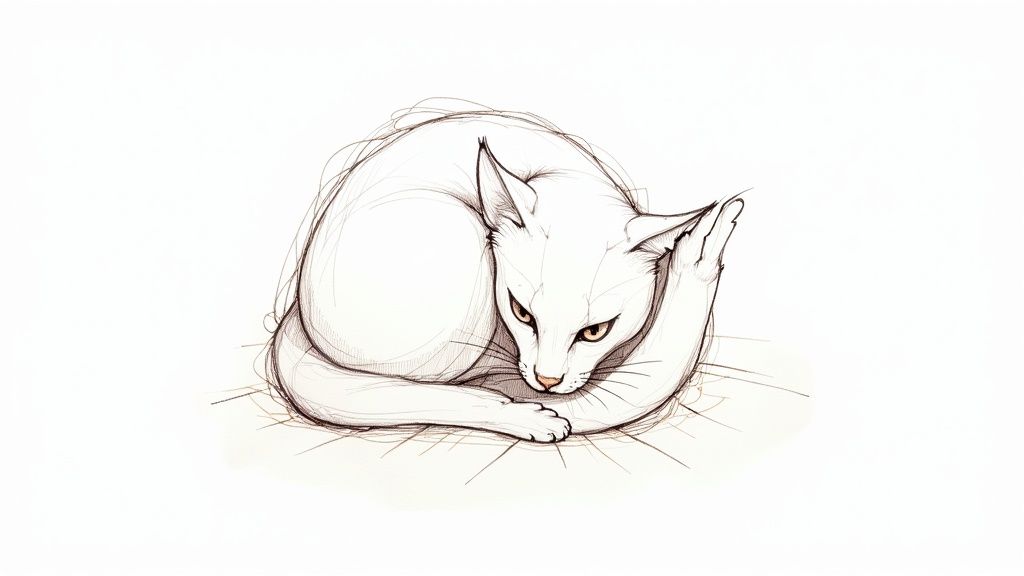
Creating Your Minimalist Masterpiece
To excel at minimalist line art, you must develop a keen eye for what makes an animal unique and practice drawing with intention and confidence. The goal is suggestion, not explicit rendering.
- Study Key Features: Before drawing, identify the most distinctive traits of your animal. Is it the floppy ears of a beagle, the bushy tail of a squirrel, or the curved beak of a toucan? Focus your entire drawing around accentuating these one or two features.
- Use Confident, Smooth Strokes: Minimalist art relies on the quality of the line itself. Practice gesture drawing to build muscle memory for creating smooth, unbroken lines. Avoid hesitant, scratchy marks, as they can disrupt the clean aesthetic.
- Embrace Negative Space: The empty space around and within your drawing is just as important as the lines themselves. Use it strategically to define form and guide the viewer's eye. This technique is especially powerful when creating minimalist animal silhouettes.
- Vary Line Weight: A single, uniform line can look flat. Experiment with varying the thickness of your line to create a sense of depth, hierarchy, and visual interest. A thicker line can suggest weight or proximity, while a thinner one can indicate delicate features.
7-Style Cute Animal Drawing Comparison
Style | Implementation Complexity | Resource Requirements | Expected Outcomes | Ideal Use Cases | Key Advantages |
|---|---|---|---|---|---|
Kawaii-style Animals | Low | Basic drawing tools, pastel colors | Cute, simple, emotionally engaging | Merchandise, beginner projects, digital/traditional art | Universally appealing, easy to draw, marketable |
Chibi Animal Art | Moderate | Drawing materials or digital tools | Highly expressive, playful characters | Comics, stickers, mobile games, digital animation | Expressive, flexible style, appeals to many ages |
Watercolor Animal Portraits | High | Quality watercolor paper, paints | Soft, dreamy, unique, textured artworks | Home decor, gifts, children's books | Emotionally appealing, creative, unique pieces |
Vector-style Flat Design Animals | Moderate to High | Vector software (Illustrator, Figma) | Clean, scalable, modern illustrations | Digital apps, branding, web graphics | Infinitely scalable, fast once mastered, professional look |
Realistic Pencil Animal Sketches | High | Quality pencils, paper, references | Detailed, photorealistic, skilled art | Fine art, portfolios, pet portraits | Demonstrates skill, timeless, fine art appeal |
Digital Art Stylized Animals | Moderate to High | Digital tablet, software (Photoshop, Procreate) | Vibrant, versatile, highly editable artwork | Digital prints, game art, animations | Unlimited color use, easy revisions, special effects |
Minimalist Line Art Animals | Moderate | Basic drawing tools or digital | Simple, elegant, recognizable designs | Logos, tattoos, minimalist decor | Quick execution, timeless, versatile |
From Blank Page to Cute Creation
We've journeyed through a delightful menagerie of artistic styles, from the charmingly simple forms of Kawaii to the expressive depth of realistic pencil sketches. Each of the seven approaches we explored offers a unique pathway to creating captivating and cute animal drawings. The true power lies not in mastering a single style, but in understanding the core principles behind each one and building a versatile artistic toolkit.
Think of each style as a different lens through which to view your subject. The bold, clean aesthetic of vector art forces you to think in shapes and color, while the delicate bleeds of watercolor encourage you to embrace imperfection and flow. Minimalist line art trains your eye to find the essential form of an animal, and Chibi art pushes you to master the art of expressive exaggeration. By experimenting across these methods, you are not just learning to draw a cute fox; you are learning multiple visual languages to express "cuteness" itself.
Key Takeaways for Your Artistic Journey
To truly elevate your work, focus on the fundamental concepts we've touched upon. Remember that the "cute" factor often comes from specific, intentional choices:
- Proportion is Paramount: Whether you're creating a Chibi character with a large head and small body or a realistic fawn with oversized, soulful eyes, manipulating proportions is your most powerful tool for evoking an "aww" response.
- Simplify for Impact: Many of the most effective cute animal drawings rely on simplification. This could mean reducing an animal to its basic geometric shapes in a vector design or capturing its essence with a single, unbroken line in minimalist art. Don't be afraid to leave details out.
- Texture Adds Personality: The soft fur rendered with pencil, the gentle wash of watercolor, or the clean, flat look of a digital piece all contribute to the final character of your drawing. The right texture can make a simple drawing feel warm, playful, or gentle.
Your Actionable Next Steps
The journey from inspiration to creation is an active one. Don't let these ideas remain on the page; it's time to put your pencil, stylus, or brush to work. Start by choosing one style from this list that genuinely excites you or feels just outside your comfort zone. Find a reference photo of your favorite animal and commit to creating one finished piece using that technique.
Challenge yourself to not just copy the style, but to understand why it works. Ask yourself: what specific elements make this drawing cute? Is it the color palette? The line weight? The facial expression? By actively analyzing as you create, you will internalize these concepts and begin to develop your own unique artistic voice. The goal is to move beyond imitation and into innovation, blending these techniques to bring your own imaginative creatures to life. Your sketchbook is a playground, so don't hesitate to fill it with experiments, happy accidents, and a whole lot of adorable animals.
Ready to conquer artist's block and find your next project? The Drawing List platform offers an incredible Drawing Ideas Generator with 99+ categories, perfect for sparking your creativity with endless prompts for cute animal drawings. Visit Drawing List to discover unique ideas that will keep you inspired and drawing every day.
